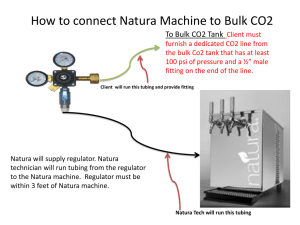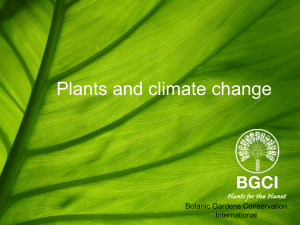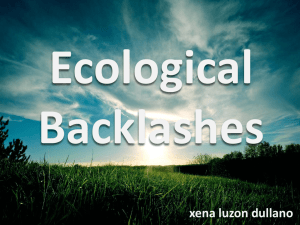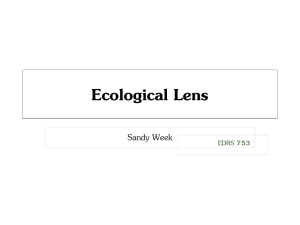Presentation_Ivana_and_Biljana
advertisement
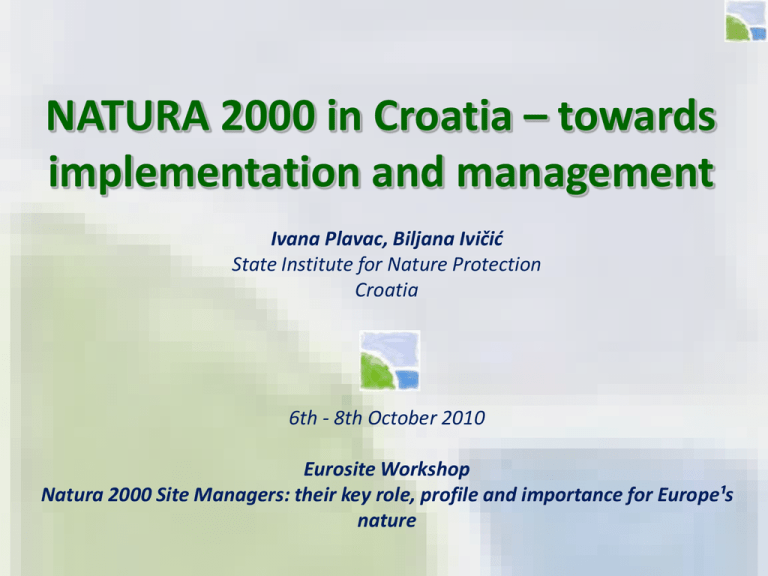
NATURA 2000 in Croatia – towards implementation and management Ivana Plavac, Biljana Ivičić State Institute for Nature Protection Croatia 6th - 8th October 2010 Eurosite Workshop Natura 2000 Site Managers: their key role, profile and importance for Europe¹s nature Outline of the presentation Preparation of the NATURA 2000 proposal PHARE 2005 project - Implementation of the NATURA 2000 and the consultation process Management of the National Ecological Network and main issues Nature Impact Assessement NATURA 2000 proposal preparation responsibility of the State Institute for Nature Protection (SINP) as a central institution for expertise work of nature conservation in Croatia prepared through several phases, based on the best available scientific data and expert knowledge. the first phase comprised collecting and processing of relevant data from scientific institutions, individual experts and NGOs in the scope of several international projects the second phase involved coordination of the new field researches financed through the state budget the third phase, which is now finished encompassed the consultation process with all relevant stakeholder groups in the scope of PHARE 2005 project "Implementation of NATURA 2000 in Croatia", . Emerald network project – I and II phase 2001-2003, 2006 - Council of Europe, EEA The results of this project: Expert Committee for Species and Habitats has been established compilation of lists of species and habitat types by biogeographic region creation of GIS distribution maps of species and habitats determination of the status of distribution data for Emerald/NATURA 2000 species and habitats in Croatia; collection of scientific data for the purpose of draft recommendations for the amendment of Resolution nos. 4 and 6 of the Bern Convention and the corresponding EU Directives; Emerald network project – I and II phase drafting of the list of ASCI sites of the Emerald Network (potential NATURA 2000 sites)—earmarking more than 90% of the area of the future final proposal; compilation of the Emerald database for proposed ASCI sites (potential NATURA 2000 sites); definition of digital borders in GIS for all processed ASCI sites; creation of a web based application with an overview of the map of the ASCI areas and accompanying data from the Emerald database. LIFE III CRO-NEN Building-up the National Ecological Network as a Part of the PanEuropean Ecological Network & NATURA 2000 Network 2003-2005 535.850 €; 70% (375.000 €) EC Main tasks: training of nature protection authorities related to EU legislation, NATURA 2000 commitments and building up of ecological network building up the National Ecological Network which will include species and habitat types threatened or rare on national level; parts of the CRO-NEN to be proposed as potential sites of NATURA 2000 development of the network of people involved in data gathering LIFE III CRO-NEN Building-up the National Ecological Network as a Part of the PanEuropean Ecological Network & NATURA 2000 Network 2005-2006. revision of the CRO-NEN based on the newly gathered scientific data 2007. Regulation on the proclamation of Ecological Network (NN 109/2007) - proclaims the ecological network of the Republic of Croatia with the system of ecologically important areas and ecological corridors with conservation objectives and guidelines for conservation measures which are aimed at maintaining or establishing a favourable status of threatened and rare habitat types and/or wild taxa. LIFE III CRO-NEN Building-up the National Ecological Network as a Part of the PanEuropean Ecological Network & NATURA 2000 Network 2005-2006. revision of the CRO-NEN based on the newly gathered data 2007. Regulation on the proclamation of Ecological Network (NN 109/2007) - proclaims the ecological network of the Republic of Croatia with the system of ecologically important areas and ecological corridors with conservation objectives and guidelines for conservation measures which are aimed at maintaining or establishing a favourable status of threatened and rare habitat types and/or wild taxa. Indicated Potential NATURA 2000 sites Target feature Guidelines for conservation measures LIFE III CRO-NEN Building-up the National Ecological Network as a Part of the PanEuropean Ecological Network & NATURA 2000 Network www.cro-nen.hr/nem II. Phase – Coordination of the new field researches financed through the state budget 2006. – 2010. systematic field data gathering, mobilisation of the scientific, expert and non governmental sector researches are specifically directed for completion of the NATURA 2000 database Biodiversity od the Republic of Croatia Relatively small area 4 biogeographic regions In the process of negotiation Croatia requested to omit Panonnian region because it does not belong to it neither in terms of vegetation, floral elements nor climatic conditions, with the exception of a very small area at the easternmost part of the country – proposition has already been accepted by the Bern Convention Standing Committee, waiting for the EC to accept Biodiversity od the Republic of Croatia Significant contribution to European Natura 2000 network 223 species (birds: 87 BD I + 53 reg. migratory; other species: 136 HD II) and 72 habitat types (HD I) Amendments of Annexes I and II of the Habitats Directive Directives do not include some specifics of Croatian biodiversity so in the negotiation process with EU Croatia proposes additional species and habitat types to be added to the annexes of the HD Mostly related to carst and Mediterranean region Taxonomic groups Species proposed for amendments of Annex II of the Habitats Directive Common name Vertebrates Mammals Dinaromys bogdanovi Balkan Snow Vole Reptiles Dinarolacerta mosorensis Mosor rock lizard *Vipera ursinii macrops Karst meadow viper Aulopyge huegelii Dalmatian Barbel Salmothymus obtusirostris Adriatic trout Chondrostoma kneri Dalmatian nase Chondrostoma phoxinus Minnow nase Knipowitschia croatica Croatian goby Squalius svallizae Adriatic dace Squalius microlepis Makal dace Fishes Invertebrates Butterflies Protoerebia afra dalmata Grasshoppers Pachytrachis bosniacus Dalmatian Ringlet Plants *Degenia velebitica velebitska degenija Potential SPAs Proposal prepared by Ornithological Institute of the Academy of Sciences BirdLife International criteria 38 internationally important areas (SPA) Selection of potential SCIs NATURA 2000 habitats in Croatia are widely distributed Selection of pSCI integration of data about species and habitat distribution Selection of potential SCIs Interpretation manual for determination of terrestrial habitats according to the Habitats Directive NATURA 2000 habitat types have been recoded into the National classification of habitats Map of potential SCIs Institutions involved in preparation of the proposal: Arka Arka Association for Nature, Environment and Sustainable Development SUNCE BIOM – Association for Biological Research Blue World - Institute of Marine Research and Conservation Center for Marine Research, „Ruđer Bošković“ Institute Croatian Biospeleological Society Croatian Botanical Society Croatian Herpetological Society - HYLA Croatian Ichthyological Society Croatian Odonatological Society Platycnemis Croatian Natural History Museum, Zagreb Department of Botany, Faculty of Science Department of Zoology, Faculty of Science Ecological Association „Emys” Faculty of Forestry Faculty of Veterinary medicine „Grupa Sredozemna Medvjedica” – Association for Research and Nature Protection Institute for Oceanography and Fisheries, Split Institute for Marine and Coastal Research , Dubrovnik Natural history museum, Rijeka Research-educational centre for the protection of nature „Caput Insulae Beli“ The Association of Environmental Protection „Val“ Phare 2005 “Institutional strengthening and implementation of the NATURA 2000 ecological network in Croatia” 2008.-2009. Total 1.611.750 €; 75% EC (1.538.048 €) Three main tasks: completing the NATURA 2000 proposal and consultation process with all relevant stakeholders creation of two management plans for potential NATURA 2000 areas were developed in cooperation with local stakeholders the training of competent bodies in the mechanisms of nature impact assessements Phare 2005 - NATURA 2000 consultation process for a successful implementation it is necessary to have a good image of NATURA 2000 from the very beginning so it was very important to start a process of institutional and public awareness raising the consultation process comprised few major steps shown Phare 2005 - NATURA 2000 consultation process A pre-step for a successful consultation phase is a certain level of basic information - for that purpose www.natura2000.hr website has been created and the most important part of the website was the interactive map where users can easily search through proposed NATURA 2000 sites in their region. Phare 2005 - NATURA 2000 consultation process Searching the interactive map by locations Phare 2005 - NATURA 2000 consultation process Searching the interactive map by species Phare 2005 - NATURA 2000 consultation process Basic information about the site from the database 1. round of sectoral workshops forestry, water management, agriculture, physical planning, nature protection, scientific community, NGOs every session started with brief information about NATURA 2000 in Europe and Croatia, followed by the “question and answer” session, after that an interactive phase was scheduled to discuss rumours, fears and opportunities at the end participants filled out evaluation sheets 1. round of sectoral workshops For better understanding of NATURA 2000, specific sectoral brochures were made for each sector Reports of the each workshop were published on web 2 days regional workshops (Osijek, Varazdin, Rijeka, Karlovac, Split) 1st Day NATURA 2000 in general 2nd Day NIA and NATURA 2000 • Situation in Europe • Situation in Croatia • Examples • Plenary Discussion • NIA in general • What is significant impact • Compensation and mitigation measures • Public interest • Alternative solutions 2. round of sectoral workshops In the 2nd round the agenda was focussed on remaining or new questions how SINP plans to realize additional ideas and requests SINP wanted to inform all participants how the results of the first round of workshops have been implemented in the proposal of site-designation Changes based on participants comments Changes based on refining site boundaries Changes based on new scientific dana All changes to the proposal were made in line with the requirements of the HD and BD; in accordance to its criteria Conclusions from the workshops more than 300 inputs and comments have been worked out in the working groups more than 300 different questions have been answered the comments of the participants referred to the proposal of NATURA 2000 sites as well as to general expectations, requests or ideas for further cooperation. all reports of the workshops and presentations are published on web and were sent to the participants for many participants these workshops were only a starting point for more discussions and they expect further activities how they will be involved in the whole NATURA 2000 process Working group for forests has been established – discussion about conservation measures Agreement with physical planning sector has been made to organize meetings with every county authority about exchange of digital geographical data and precise definition of site boundaries Next steps: IPA 2007 Identification and setting-up of the marine part of NATURA 2000 network in Croatia – starts in November 2010 Total ≈527.000 € a detailed plan to determine all potential NATURA 2000 marine sites will be developed, in co-operation with international experts deep sea mapping training on monitoring and reporting in line with the requirements of the HD training of amateurs, including members of diving clubs and centres for mapping and monitoring of marine species and habitats Next steps: IPA 2009 Natura 2000 management and monitoring — (MAN-MON) – starts in 2011 Total ≈ 1.250.000 € purpose of this project is to build capacities on national and county level for management of NATURA 2000 sites to develop 6 management plans for selected potential NATURA 2000 sites to contribute to development and implementation of the national monitoring framework needed for reporting according to the Habitats Directive Management of NATURA 2000 sites According to the Nature Protection Act, the future regulation on NATURA 2000 network will prescribe conservation measures for each site In the framework of PHARE 2005 project, draft conservation measures for groups of potential NATURA 2000 sites have been developed Croatia will designate NATURA 2000 network by the day of the accession to the EU but already, by the Regulation on the proclamation of Ecological Network (NN 109/2007), has transposed all main requirements of the Habitat Directive into the national legislation Potential NATURA 2000 sites have been proclaimed and nature impact assessement is carried out in accordance with Article 6. Conservation and management of ecological network areas according to the Regulation on NEN Article 3 Conservation measures related to ecological network sites are established on the basis of guidelines for conservation measures listed in appendix Guidelines for protection measures related to ecological network site apply to all natural and legal persons who exploit natural resources in those areas and perform activities and projects in line with the Act. Data on whether the scope of a document or plan affects an ecological network site shall be entered into physical planning documents and natural resource management plans. Conservation and management of ecological network areas according to the Regulation on NEN Article 4 Ecological network site, which is at the same time proclaimed as a protected area in line with the Nature Protection Act, shall be managed by a public institution on the national level. Ecological network site, which is located outside a protected area, and is not specially protected, shall be managed by a public institution for managing protected natural values which is established by a regional self-government unit (PI on the county level), Ecological network site which is located on the territory of two or more counties shall be jointly managed by public institutions for managing protected natural values of those counties. In Croatia, there are currently 19 public institions at the national level (National and Nature Parks) and 20 at the county level Conservation and management of ecological network areas according to the Regulation on NEN Article 5 Protection of ecological network sites is ensured by implementation of the prescribed conservation measures and nature protection requirements issued by the nature protection authority A management plan for the purpose of conserving each site within the ecological network shall be adopted for ecological network sites If an ecological network site is at the same time protected area, the Protected Area Management Plan shall be considered as the Ecological Network Management Plan If an ecological network site is not protected, the Ecological Network Management Plan is adopted by a public institution for managing protected natural values on the county level Exploitation of natural resources in an ecological network site is performed on the basis of natural resource management plans, which contain measures and requirements for nature protection Management plans So far 13 management plans have been prepared in the framework of several international projects, 10 are in preparation, and 6 are planned “Karst Ecosystems Conservation” project financed by the Global Environment Fund (GEF) via a World Bank 2003. – 2008. - five management plans for five PAs (Nature Park Velebit, National Parks Paklenica, Risnjak, Sjeverni Velebit and Plitvice lakes “Developing a model for the conservation of Croatia’s grassland biodiversity” – financed by Darwin Initiative for the Survival of Species – 2004. – 2007. – management plan for Nature park Žumberak i Samoborsko gorje CARDS 2002 “Capacity building of the State Institute for Nature Protection” 2005. – 2006. - management plans for two small future NATURA 2000 sites were developed (Dubravica Bog and Đurđevac Sands) INTERREG IIIA HUN SLO- CRO 2004-2006 “Establishment of the transboundary network of karstic protected areas and their joint management” – 2006. – 2008. – management plan for Nature Park Učka LIFE05 “Central Posavina – Wading toward Integrated Basin management” – 2006. – 2008. – management plan for Nature park Lonjsko polje The PHARE 2005 “Institutional Building and Implementation of NATURA 2000 in Croatia” 2008. - 2009. - preparation of the management plan for Vransko Lake Nature Park and Jasen candidate Natura 2000 site and development of the management plan for the candidate Natura 2000 site important for large carnivores „Capacity building of local public institutions for management of protected natural values, in process of legislative alignment with EU“financed by Swedish fund SIS – 2008. - 2 management plans for ecological network sites and proposed NATURA 2000 sites are prepared MP for Drežničko polje including Polje Lug and MP for Dretulja river „Strategic Partnership for the Mediterranean Sea Large Marine Ecosystem - Pilot-project for Croatian marine protected areas“ (MedPan) – 2009. – 2012. - financed by FFEM and WWP-MedPO, RAC/SPA)- development of 5 management plans for selected marine parks: national parks Kornati, Mljet and Brijuni, as well as nature parks Telašćica and Lastovo archipelago - in preparation IPA 2009 “Natura 2000 management and monitoring” (MAN-MON) – 2011. - 2012. - development of 6 management plans for six potential NATURA 2000 sites (alluvial forests in Vukovar-Srijem County, locality Pregon in Istria County, complex Mediterranean fields and mountain areas in Dubrovnik-Neretva County, Odransko polje in Sisak-Moslavina County, locality Bulji in Lika-Senj County, transboundaryriver in KrapinaZagorje County - planned General issues about management and management plans The state has put the responsibility of management of National ecological network sites on public institutions for managing protected natural values, PIs of areas protected by the NPA are relatively well capacitated and are financed through the state budget, but they are responsible for only 19 sites, and still it is not clearly determined by the legislation are they obliged for management of the parts of the sites whose boundaries extent outside the boundaries of the PAs, County PIs are under capacitated and struggling with constant need for ensuring funds – not enough directed to self-initiatively search for external funding in the framework of some international projects beacuse of the lack of capacity; relying on the county budget which is not sufficient, they are not funded by the state budget All these issues result in a small number of management plans Most of the management plans done in the past are bounded to areas protected by NPA and are more oriented to a classical way of conserving the area and not specifically directed to the conservation of favourable conservation status of target species and habitats.
